
Chapter 13: DNA <
13.1 Identifying the Substance of the Gene
A gene is a unit of heredity that’s passed down to offspring and determines physical and biological traits. To figure out how this works, scientists needed to discover the chemical nature of genes and what exactly in the gene held genetic information.
An experiment that contributed to this topic was done by Frederick Griffith, who aimed to investigate pneumonia but discovered something else instead.
Griffith’s Experiment
Done in 1928, this experiment involved injecting mice with different strains of bacteria. He discovered that a non-virulent strain could be transformed into a virulent strain when mixed with heat-killed virulent bacteria. 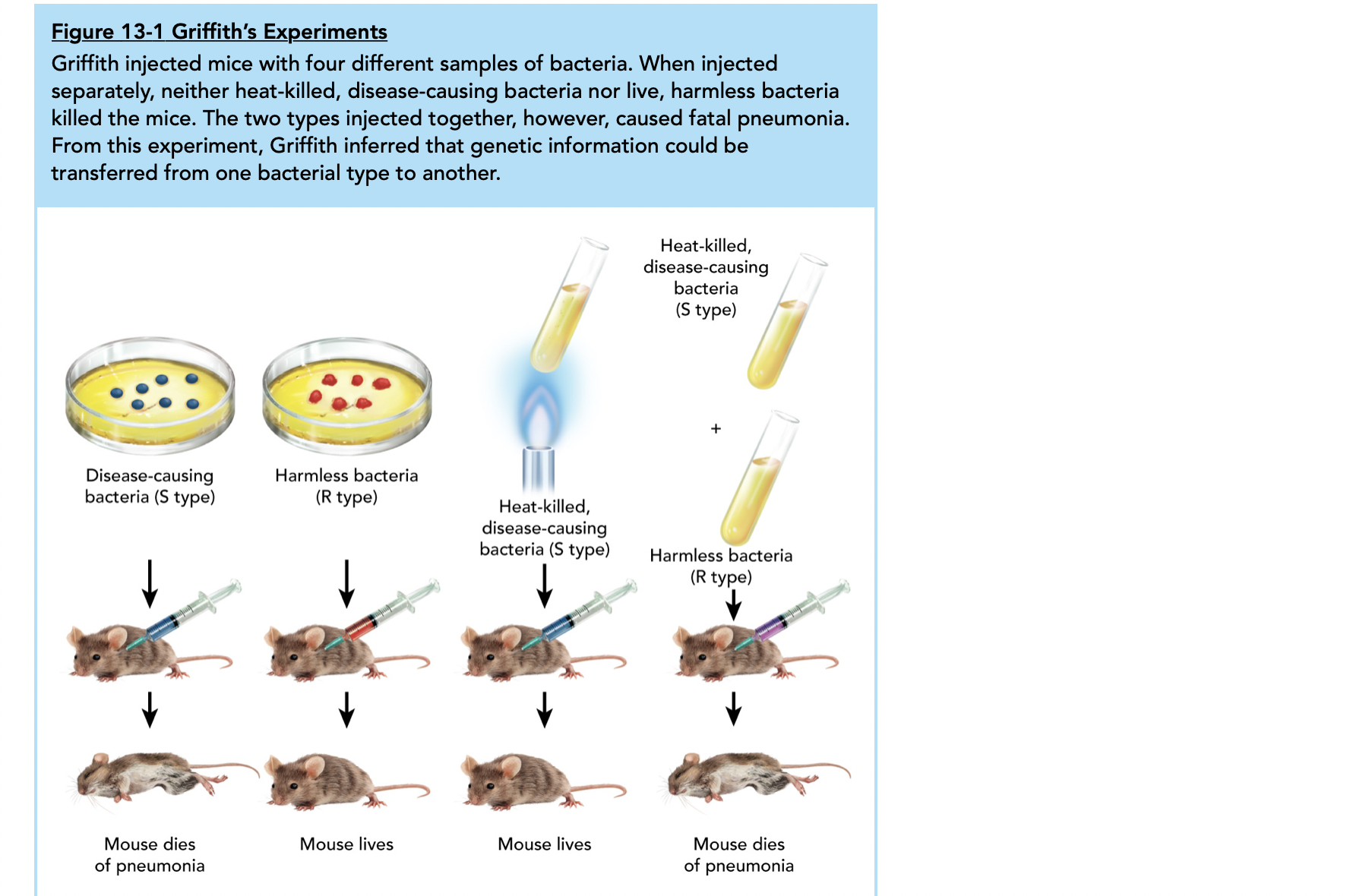 This was due to the transfer of genetic material from the dead virulent bacteria to the live non-virulent bacteria, a process known as transformation. This experiment laid the foundation for the discovery of DNA as the genetic material by showing how genetic information could be transferred.
This was due to the transfer of genetic material from the dead virulent bacteria to the live non-virulent bacteria, a process known as transformation. This experiment laid the foundation for the discovery of DNA as the genetic material by showing how genetic information could be transferred.
Transformation: When a genetic alteration occurs, resulting from the uptake of genetic material
This experiment was repeated again in 1944 to identify the molecule that caused transformation instead. They used enzymes that destroyed proteins and saw that transformation still occurred, meaning that proteins were not responsible for transformation. They tried this again, but with enzymes that broke down DNA, and saw that transformation did not occur. Through this process, they realized that DNA was responsible for storing and transmitting genetic information from parent to offspring.
Bacteriophage Experiment
Despite the prior experiment results, many were still skeptical since chromosomes had more protein than DNA. Therefore, another experiment was conducted in 1952 involving bacteriophages and viruses.
Viruses infect cells by attaching to the surface and injecting genetic information. The scientists were able to determine which part of the virus was injected into the bacteria, they grew viruses containing radioactive isotopes of phosphorous-32 and sulfur-35. Since proteins contain almost no phosphorous and DNA contains no sulfur, these could be used as markers. In the end, phosphorous-32 was found in the bacteria, meaning that DNA was the genetic material. 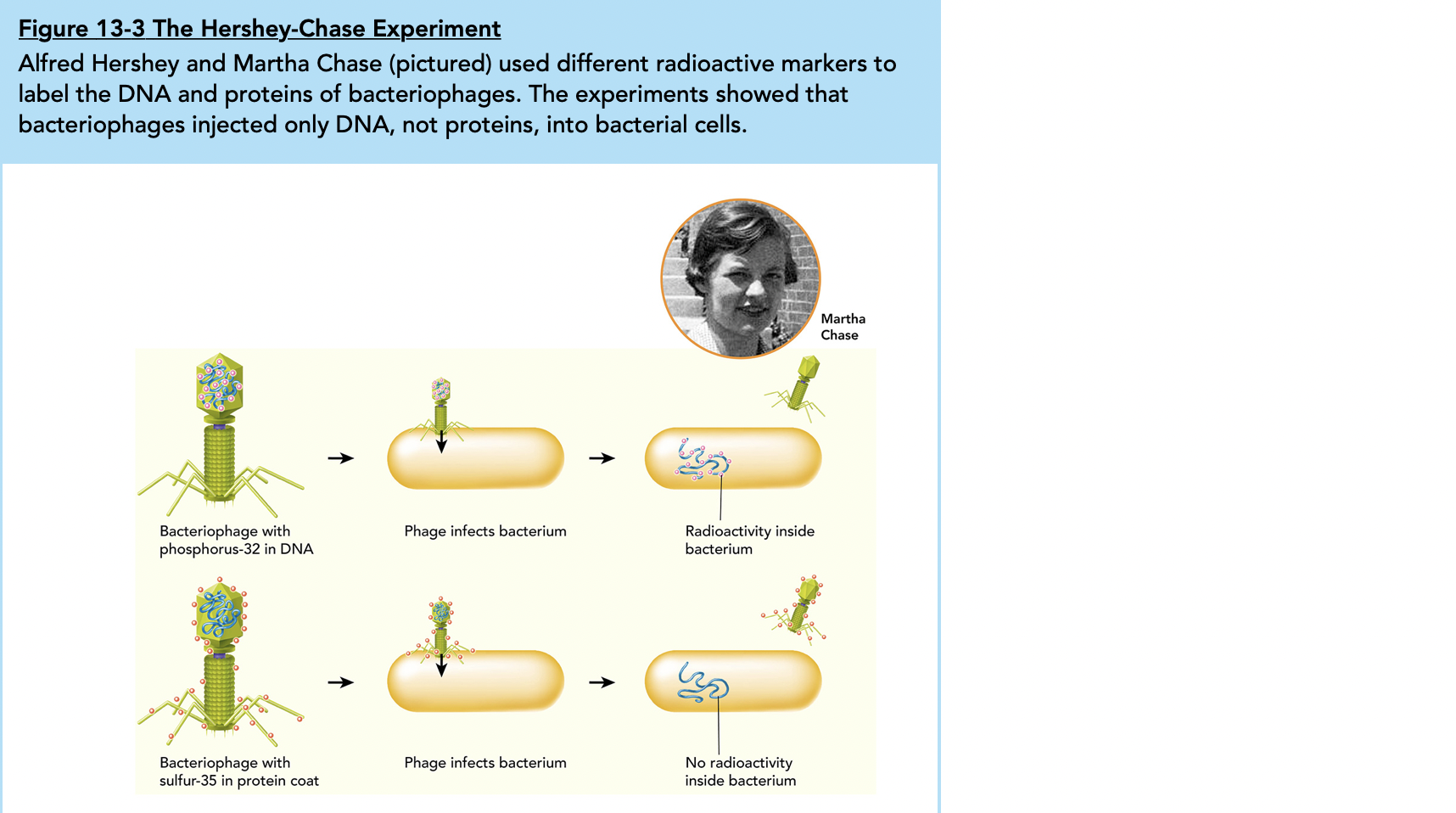
DNA’s roles
☆Storing Information
DNA plays a large role in heredity since it can store genetic information meaning it contains the instructions that a cell needs to develop into its respective organism (ex- oak tree, sea urchin, dog).
A purple flower must have the information it needs to make purple pigment which is where DNA comes into play.
☆Copying Information
In cell division, DNA replication occurs, creating two identical DNA molecules
When a cell divides in the purple flower, it must make a copy of the purple pigment gene
☆Gene Expression
Cells also must be able to use the genetic information and "put it to work" by turning it into a function
The cells must produce enzymes that make the purple pigment
13.2 The Structure of DNA
DNA is composed of nucleotides, building blocks of nucleic acids, joined by covalent bonds. The three parts are the 5-carbon sugar (deoxyribose), a phosphate group, and a nitrogenous base. When nucleotides join, strands of DNA are formed.
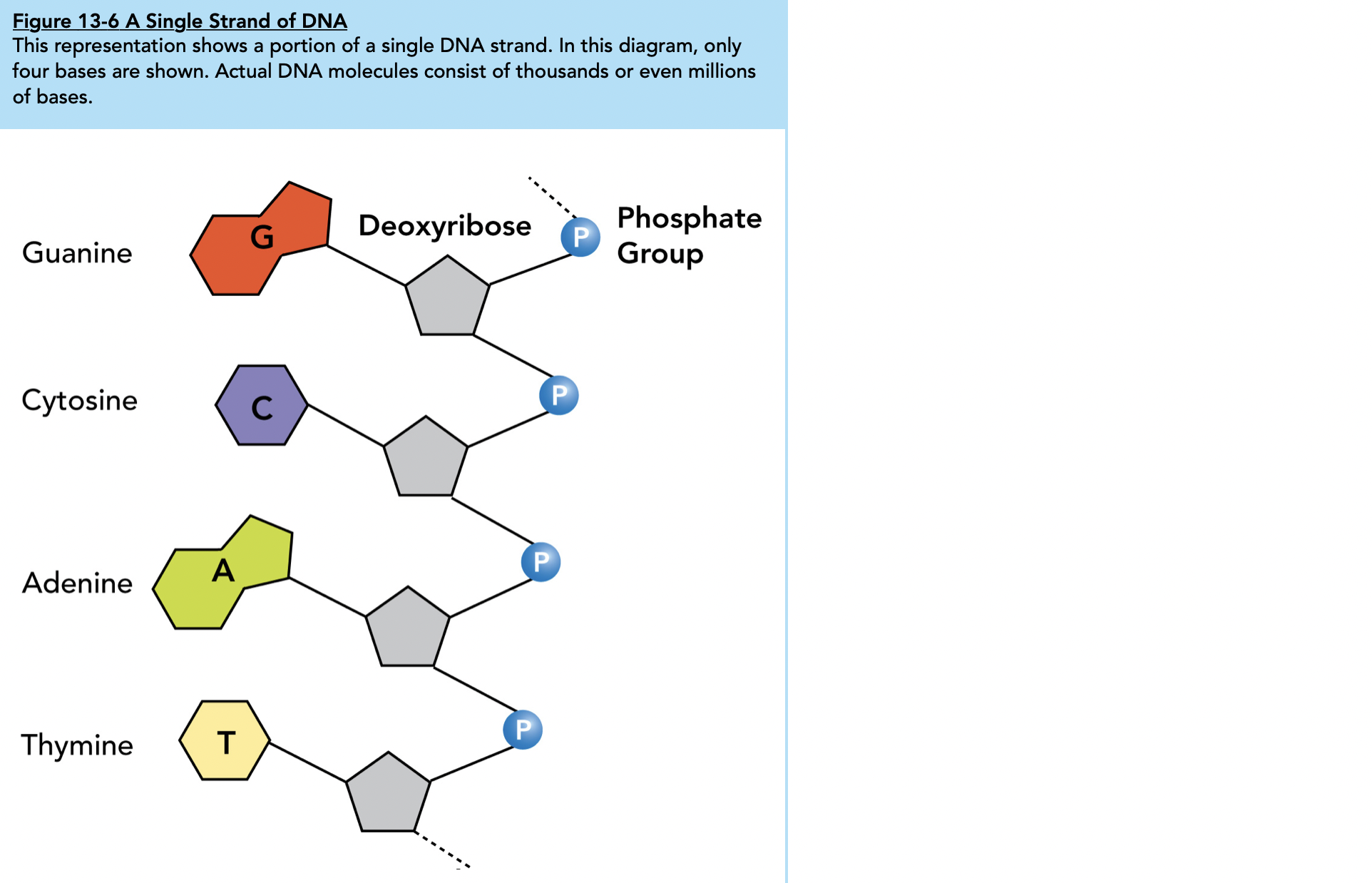
Chargaff's rule states that in DNA, the amount of adenine (A) is nearly equal to the amount of thymine (T), and the amount of guanine (G) is nearly equal to the amount of cytosine (C). This means that the base pairs A-T and G-C are complementary to each other.
Watson and Crick were scientists who also looked to explain DNA, and with Franklin's work, they gained the clues they needed to create a model of DNA to explain the specific structure and properties. The base-pairing rule was important in this because it helped determine the structure of DNA in Rosalind Franklin's Photo 51 which depicts an X-shaped pattern known as the double helix, and how the nitrogenous bases are positioned.
The Double Helix Model
The double helix model is the DNA structure, consisting of two strands of nucleotides twisted together in a spiral shape. The nucleotides are composed of a sugar molecule, a phosphate group, and a nitrogenous base.
Nitrogenous bases pair up in a specific way (adenine with thymine, and guanine with cytosine) to form the "rungs" of the DNA ladder.
Proposed by James Watson and Francis Crick in 1953, and provided a mechanism for the replication and transmission of genetic information.
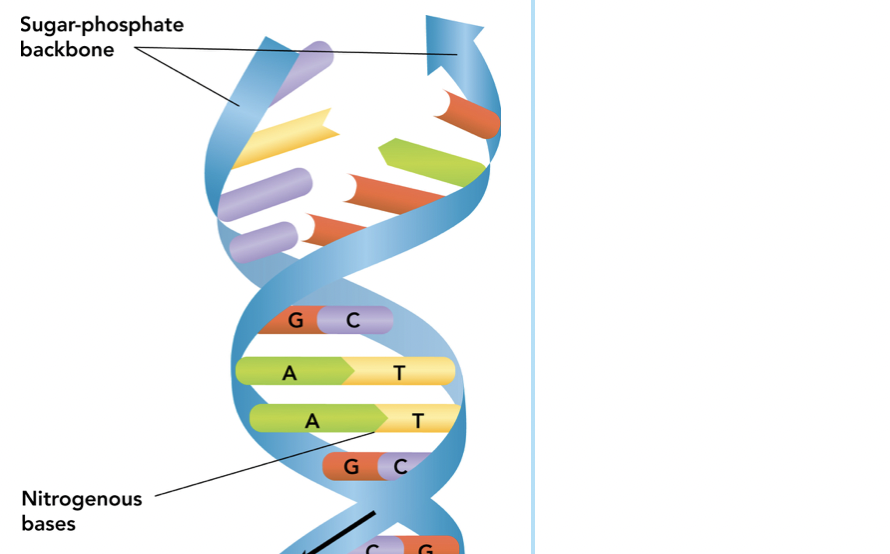
The strands of the double-helix are anti-parallel meaning they run in opposite directions, allowing the bases on each side to come in contact in the center as well as allowing each strand to have a sequence of nucleotides
Hydrogen bonds forming between certain nitrogenous bases (A-T, G-C) hold the strands together, this is known as base-pairing
Although hydrogen bonds are on the weaker side, this is essential because the two strands must be able to separate from one another
13.3 DNA Replication
Before cell replication, DNA replication must first happen during the S phase of the cell cycle. Refer to the previous note. Each strand of the double helix has the information needed to make the other strand, so they are complementary.
Basics:
Helicase unwinds the double-stranded DNA
DNA polymerase adds complementary nucleotides to each strand
Primase synthesizes RNA primers to initiate replication
DNA ligase joins the Okazaki fragments on the lagging strand
The leading strand is synthesized continuously, while the lagging strand is synthesized in fragments called Okazaki fragments
Components involved: DNA polymerase, helicase, primase, DNA ligase, nucleotides, and RNA primers.
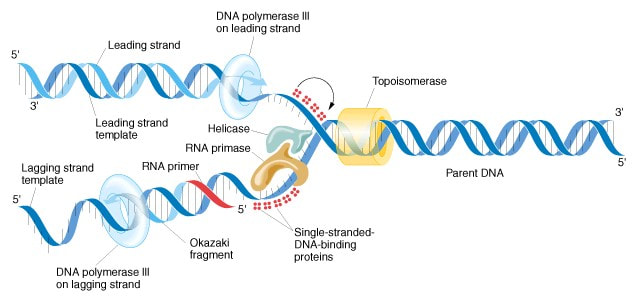
During DNA replication, the leading strand is synthesized continuously in the 5' to 3' direction, while the lagging strand is synthesized discontinuously in the opposite direction. The lagging strand is synthesized in short fragments called Okazaki fragments, which are later joined together by DNA ligase. This occurs because DNA polymerase can only add nucleotides to the 3' end of a growing strand.
Helicase: An enzyme that unzips the two strands of DNA by breaking the hydrogen bonds between two bases
Single Stranded Binding Proteins (SSB): Binds DNA strands to keep them separated
Primase: Adds RNA primer, a segment of nucleotides complementary to the DNA sequence (needed because DNA polymerase cannot initiate a nucleotide chain)
DNA Polymerase III: An enzyme that assembles nucleotides and replicates DNA molecules to build a new strand of DNA
DNA polymerase I: removes the RNA primers (placed by primase) and replaces them with nucleotides
Ligase: Links the Okazaki fragment
Chapter 13: DNA <
13.1 Identifying the Substance of the Gene
A gene is a unit of heredity that’s passed down to offspring and determines physical and biological traits. To figure out how this works, scientists needed to discover the chemical nature of genes and what exactly in the gene held genetic information.
An experiment that contributed to this topic was done by Frederick Griffith, who aimed to investigate pneumonia but discovered something else instead.
Griffith’s Experiment
Done in 1928, this experiment involved injecting mice with different strains of bacteria. He discovered that a non-virulent strain could be transformed into a virulent strain when mixed with heat-killed virulent bacteria.  This was due to the transfer of genetic material from the dead virulent bacteria to the live non-virulent bacteria, a process known as transformation. This experiment laid the foundation for the discovery of DNA as the genetic material by showing how genetic information could be transferred.
This was due to the transfer of genetic material from the dead virulent bacteria to the live non-virulent bacteria, a process known as transformation. This experiment laid the foundation for the discovery of DNA as the genetic material by showing how genetic information could be transferred.
Transformation: When a genetic alteration occurs, resulting from the uptake of genetic material
This experiment was repeated again in 1944 to identify the molecule that caused transformation instead. They used enzymes that destroyed proteins and saw that transformation still occurred, meaning that proteins were not responsible for transformation. They tried this again, but with enzymes that broke down DNA, and saw that transformation did not occur. Through this process, they realized that DNA was responsible for storing and transmitting genetic information from parent to offspring.
Bacteriophage Experiment
Despite the prior experiment results, many were still skeptical since chromosomes had more protein than DNA. Therefore, another experiment was conducted in 1952 involving bacteriophages and viruses.
Viruses infect cells by attaching to the surface and injecting genetic information. The scientists were able to determine which part of the virus was injected into the bacteria, they grew viruses containing radioactive isotopes of phosphorous-32 and sulfur-35. Since proteins contain almost no phosphorous and DNA contains no sulfur, these could be used as markers. In the end, phosphorous-32 was found in the bacteria, meaning that DNA was the genetic material. 
DNA’s roles
☆Storing Information
DNA plays a large role in heredity since it can store genetic information meaning it contains the instructions that a cell needs to develop into its respective organism (ex- oak tree, sea urchin, dog).
A purple flower must have the information it needs to make purple pigment which is where DNA comes into play.
☆Copying Information
In cell division, DNA replication occurs, creating two identical DNA molecules
When a cell divides in the purple flower, it must make a copy of the purple pigment gene
☆Gene Expression
Cells also must be able to use the genetic information and "put it to work" by turning it into a function
The cells must produce enzymes that make the purple pigment
13.2 The Structure of DNA
DNA is composed of nucleotides, building blocks of nucleic acids, joined by covalent bonds. The three parts are the 5-carbon sugar (deoxyribose), a phosphate group, and a nitrogenous base. When nucleotides join, strands of DNA are formed.

Chargaff's rule states that in DNA, the amount of adenine (A) is nearly equal to the amount of thymine (T), and the amount of guanine (G) is nearly equal to the amount of cytosine (C). This means that the base pairs A-T and G-C are complementary to each other.
Watson and Crick were scientists who also looked to explain DNA, and with Franklin's work, they gained the clues they needed to create a model of DNA to explain the specific structure and properties. The base-pairing rule was important in this because it helped determine the structure of DNA in Rosalind Franklin's Photo 51 which depicts an X-shaped pattern known as the double helix, and how the nitrogenous bases are positioned.
The Double Helix Model
The double helix model is the DNA structure, consisting of two strands of nucleotides twisted together in a spiral shape. The nucleotides are composed of a sugar molecule, a phosphate group, and a nitrogenous base.
Nitrogenous bases pair up in a specific way (adenine with thymine, and guanine with cytosine) to form the "rungs" of the DNA ladder.
Proposed by James Watson and Francis Crick in 1953, and provided a mechanism for the replication and transmission of genetic information.

The strands of the double-helix are anti-parallel meaning they run in opposite directions, allowing the bases on each side to come in contact in the center as well as allowing each strand to have a sequence of nucleotides
Hydrogen bonds forming between certain nitrogenous bases (A-T, G-C) hold the strands together, this is known as base-pairing
Although hydrogen bonds are on the weaker side, this is essential because the two strands must be able to separate from one another
13.3 DNA Replication
Before cell replication, DNA replication must first happen during the S phase of the cell cycle. Refer to the previous note. Each strand of the double helix has the information needed to make the other strand, so they are complementary.
Basics:
Helicase unwinds the double-stranded DNA
DNA polymerase adds complementary nucleotides to each strand
Primase synthesizes RNA primers to initiate replication
DNA ligase joins the Okazaki fragments on the lagging strand
The leading strand is synthesized continuously, while the lagging strand is synthesized in fragments called Okazaki fragments
Components involved: DNA polymerase, helicase, primase, DNA ligase, nucleotides, and RNA primers.

During DNA replication, the leading strand is synthesized continuously in the 5' to 3' direction, while the lagging strand is synthesized discontinuously in the opposite direction. The lagging strand is synthesized in short fragments called Okazaki fragments, which are later joined together by DNA ligase. This occurs because DNA polymerase can only add nucleotides to the 3' end of a growing strand.
Helicase: An enzyme that unzips the two strands of DNA by breaking the hydrogen bonds between two bases
Single Stranded Binding Proteins (SSB): Binds DNA strands to keep them separated
Primase: Adds RNA primer, a segment of nucleotides complementary to the DNA sequence (needed because DNA polymerase cannot initiate a nucleotide chain)
DNA Polymerase III: An enzyme that assembles nucleotides and replicates DNA molecules to build a new strand of DNA
DNA polymerase I: removes the RNA primers (placed by primase) and replaces them with nucleotides
Ligase: Links the Okazaki fragment
 Knowt
Knowt